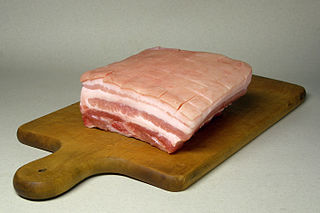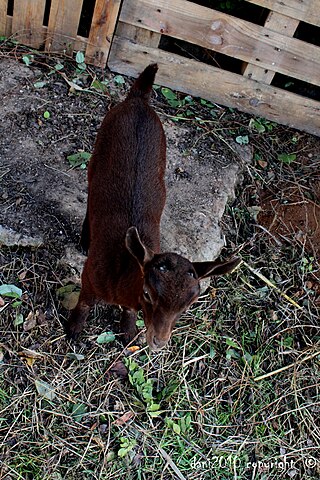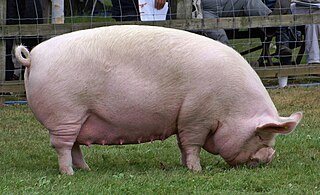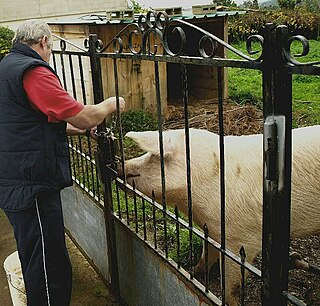Related Research Articles

Cumberland sausage is a pork sausage that originated in the historic county of Cumberland, England, ceremonially part of Cumbria. It is traditionally very long, up to 50 centimetres, and sold rolled in a flat, circular coil, but within western Cumbria, it is more often served in long, curved lengths.

The pig, also called swine or hog, is an omnivorous, domesticated, even-toed, hoofed mammal. It is named the domestic pig when distinguishing it from other members of the genus Sus. It is considered a subspecies of Sus scrofa by some authorities, but as a distinct species by others. Pigs were domesticated in the Neolithic, both in East Asia and in the Near East. When domesticated pigs arrived in Europe, they extensively interbred with wild boar but retained their domesticated features.

The Essex is a breed of domestic pig originating in the United Kingdom.

The Berkshire is a British breed of pig. It originated in the English county of Berkshire, for which it is named. It is normally black, with some white on the snout, on the lower legs, and on the tip of the tail.
The Aksai Black Pied is a distinctively black and white spotted pig breed from Kazakhstan.

The Poland China is an American breed of domestic pig. It was first bred in Warren County in Ohio, in the American Midwest. Its origins lie in a small number of pigs of Chinese type bought in 1816, which were cross-bred with a variety of breeds of European origin including the Berkshire. It was bred as a lard pig, and is among the largest of all pig breeds.

The British Saddleback is a modern British breed of domestic pig. It was created in 1967 by merging the surviving populations of two traditional saddleback breeds, the Essex and Wessex Saddleback. It is an endangered breed, listed on the watchlist of the Rare Breeds Survival Trust as at risk, the second-highest level of concern.

Pork is the culinary name for the meat of the pig. It is the most commonly consumed meat worldwide, with evidence of pig husbandry dating back to 5000 BCE.

The Murciano-Granadina is a Spanish breed of dairy goat. It was created in 1975 when two existing breeds, the mahogany-coloured Murciana of Murcia and the black Granadina of Granada, began to be hybridised as a result of the official recognition of a single herdbook including both breeds. It is the most important dairy goat breed of Spain, with more than 500,000 milking females. It originated in the semi arid areas in south eastern Spain, including parts of Murcia, Almería, Granada and Alicante. They were bred for two main traits, milk production and its ability to continue this production in dry and nutrient poor regions. They have been introduced into several areas in Latin America as well as northern Africa.

The Middle White is a British breed of domestic pig. It originated in Yorkshire, and derived from the Large White and the now-extinct Small White. It was recognised in 1852, and the first herd-book was published in 1884. It is a porker, reared for fresh pork, and is characterised by a short and sharply-upturned snout. After the Second World War it came close to extinction; although numbers have recovered somewhat, it is listed by the Rare Breeds Survival Trust as "priority" – the highest level of risk.

The Welsh is a breed of domestic pig native to Wales. It is a large white breed known for its hardiness in outdoor (extensive) farming, its long, pear-shaped body and its lop-ears. The breed was first mentioned in the 1870s, and after the Howitt committee report in 1955, became the third most common sire in the United Kingdom after the Large White pig and British Landrace pig. The Welsh pig experienced a decline in numbers in the late twentieth century because consumer demands had changed and the carcase was considered too fatty. In 2005 the breed was considered endangered and later came under the auspices of the Rare Breeds Survival Trust. Since then numbers have expanded somewhat, and by 2012, the registered breeding herd had increased to over 1000 animals.

There are a number of Basque breeds and cultivars. These are domesticated animals that have been bred - or plant species cultivated - for particular traits and features by Basque people in the Basque Country.

The Swedish Landrace is the leading breed of pig in Sweden. They have heavy drooping ears and a white coat. The Swedish strain of the Landrace pig originated from importations from neighboring countries, particularly Denmark. The Swedish Landrace have attracted attention in the United States and other nations in recent years.
The Cumberland was a breed of domestic pig that originated in the North of England; it was used to produce local delicacies like the Cumberland sausage and Cumberland ham. The breed became extinct in 1960, after changes in farming methods and a demand for less fatty meat led to it falling out of favour.

The British Landrace is a British domestic breed of pig and one of the most popular in the United Kingdom. It is pink with heavy drooping ears that cover most of the face and is bred for pork and bacon. The breed originated in the 1949 importation of 12 landrace pigs from Scandinavia — four boars and eight gilts. In 1950, the British Landrace Pig Society was formed and it opened a herd book for the first offspring born from the imported 12. They created the first pig testing scheme with a testing station at the village of Stockton-on-the-Forest in North Yorkshire.

Bacon and Hams is a 1917 book by George J. Nicholls, a member of the Institute of Certificated Grocers. The book details the then-modern bacon and ham industry beginning with the use of the pig breeds, meat processing and the distribution and pricing of cuts with a focus on the United Kingdom. The meat processing aspects focus on the popular Wiltshire cut of the time, but also includes American cuts as well. The book was described, with approbation, by the Saskatchewan Overseas Livestock Marketing Commission, as an "admirable and important treatise". Despite having entered the public domain, the book is rare and collectible and generated interest for its "unparalleled" anatomical details of pigs found in its fold-out pages.
Pork in Ireland has been a key part of the Irish diet since prehistory. Ireland's flora and fauna overwhelmingly arrived via a Neolithic land bridge from Great Britain prior to its submerging around 12,000 BP. When the very first hunter-gatherers arrived around 2,000 years later, the local ecosystem largely resembled that of modern Ireland.
Murciana, also called Murcian, Murcien, Murciene and Royal Murciana is a dual-purpose breed of goat originally bred in the Murcia province along the Mediterranean coast of southeastern Spain. The main milk-producing goat breed in Spain is a cross between the Murciana and the Granadina goat known as Murciano-granadina goat. Only the latter is officially recognized by the Spanish government, so Murciana goats are considered a variety of such breed.
The Large White Ulster, or Ulster White, was a breed of domestic pig. Primarily bred for bacon production, it was the favoured breed of farmers in the north of Ireland up until the mid 20th century.

Krškopolje pig or Black-belted pig is an autochthonous breed of pig, originating in Slovenia. This pig represents the only still preserved Slovenian autochthonous breed of domestic pig. The easily recognizable blackish Krškopolje pig, widely used for meat production, is well known for its continuous pink belt, running across animal's shoulders and forelimbs.
References
- ↑ "Archivos de Zootecnia" (PDF). Arch. Zootec. 52: 273-278. 2003.
- ↑ "Ethnozootechnical characterization and analysis of the genetic situation of the Chato Murciano pig breed" (PDF). Centro de Investigación y Desarrollo Agroalimentario.
- ↑ Case, Andy. Beautiful Pigs. Murdoch Books. ISBN 978-1-74266-127-8.
- ↑ "Local Gastronomy". Tercia de Ulea.[ permanent dead link ]
- ↑ "Chato Murciano pig breed: genetic and ethnozoological characterization" (PDF). Murcian Institute of Agricultural and Alimentary Research and Development.[ permanent dead link ]
- ↑ "Improving the quality of dry-cured sausages using pork from rustic breed" (PDF). Department of Food Technology, Nutrition and Hygiene, Veterinary Faculty, University of Murcia, Espinardo, Murcia 30071, Spain.